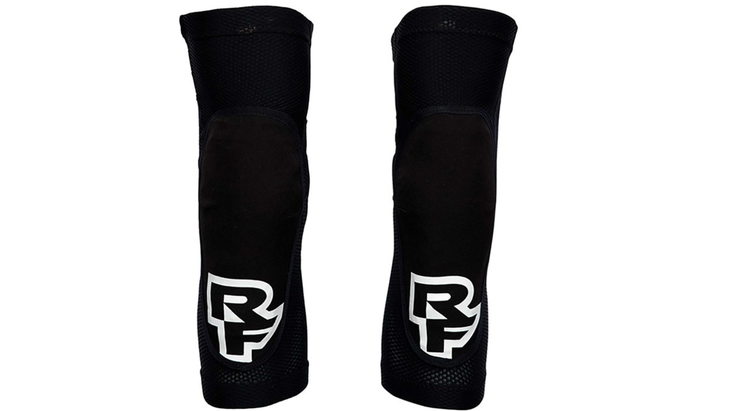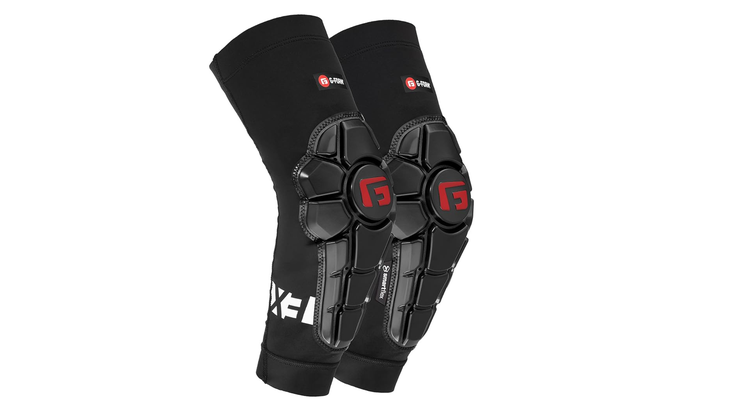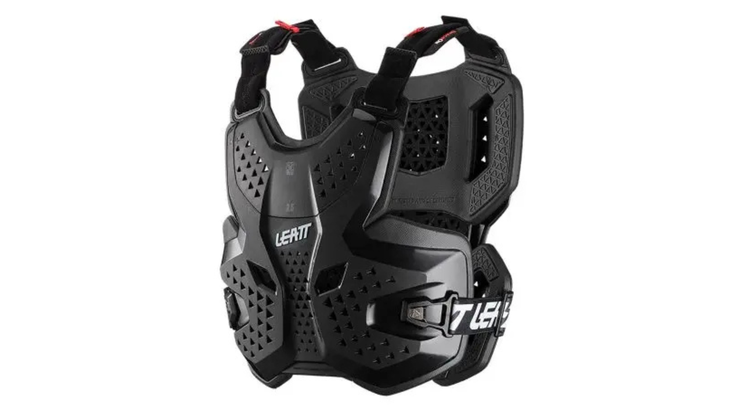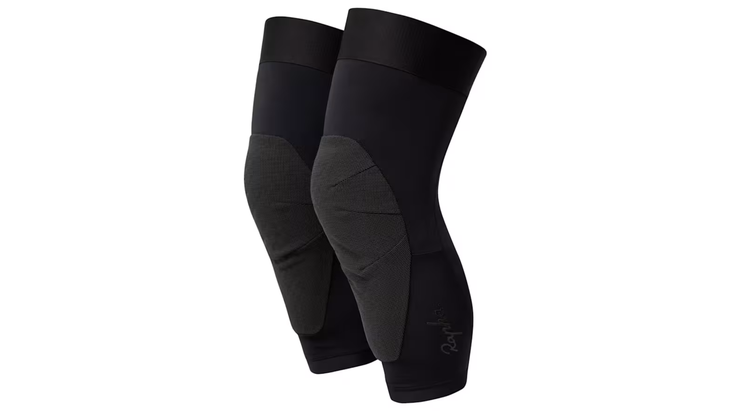Mountain bike body armor isn’t just for downhill racers and bike park regulars anymore. Modern protection has evolved: The best mountain bike protective gear is lighter, breathable, and better-fitting than ever. Whether you’re pushing into more technical terrain or just trying to avoid a season-ending spill, today’s kneepads, elbow pads, and chest protectors use advanced materials and designs that balance mobility with certified impact protection. They’re built to stay put, breathe well, and blend into your riding kit without drawing attention—until they need to.
We tested more than two dozen pieces of protective gear across trail, enduro, and gravity disciplines to find the options that actually work in the real world. From full upper-body coverage to barely there kneepads that disappear while pedaling, these are the pieces our testers kept reaching for.
At a Glance
Best Overall Kneepads
Fox Enduro Pro Knee Guards
$115 at REI $115 at Backcountry
Certifications: EN1621-1 Level 1
Fit: Slip-on sleeve with large elastic grippers
Pros and Cons:
⊕ Comfortable, pedal-friendly fit
⊕ Breathable Koroyd insert
⊕ Reinforced Cordura front panel
⊗ Limited side coverage
The Fox Enduro Pro pads earned top marks for comfort and ventilation, making them ideal for long days on technical trails. At the heart of the design is a lightweight Koroyd insert housed in a floating mesh pocket. Unlike foams that stiffen on impact, Koroyd uses an open crumple zone structure to manage energy, allowing for excellent airflow and low-profile protection.
A Cordura panel covers the front of the pad for abrasion resistance, while the sleeve’s breathable mesh wicks moisture and resists odor buildup. Testers noted that the extended sleeve design, paired with wide silicone grippers, kept the pads in place during hours of climbing and descending.
Several riders described them as the most comfortable knee guards they’d worn—light enough to forget about until needed. “They didn’t shift, bunch, or slide, even after a low-side crash,” one tester said. The slim profile also fits cleanly under pants or close-fitting trail shorts.
These are best suited for trail and enduro riders who want effective protection without sacrificing comfort. For downhill or bike park laps, you’ll want something with additional coverage. But for high-mileage riding wherever the trail takes you, the Enduro Pro hits a sweet spot.

Best Lightweight Kneepads
RaceFace Covert
$105 at Evo $100 at RaceFace
Certifications: EN1621-1 Level 1
Fit: Slip-on sleeve with silicone grippers
Pros and Cons:
⊕ Ultralight and breathable
⊕ Low-profile fit
⊗ Limited coverage
RaceFace’s Covert pads deliver certified impact protection in a breathable, low-bulk package that’s ideal for high-mileage trail rides. At the core is D3O Ghost foam, a thin and flexible material that conforms to the knee while pedaling and absorbs energy during a crash. The result is a lightweight sleeve that offers peace of mind without getting in the way.
The sleeve’s mesh back panel enhances airflow, while the front panel resists abrasion from minor spills and trail brush. Silicone grippers at the thigh, calf, and shin keep the pads locked in place, even on long, sweaty climbs.
Testers noted the Covert’s exceptional comfort, likening them to a “heavy-duty knee warmer” that stays in place throughout the ride. They’re particularly well suited for trail and cross-country riders who typically leave their pads in the pack—until now. “These are the first pads I’ve worn that I don’t want to take off halfway through the ride,” said one rider.
While they’re not designed for downhill or bike park terrain, the Covert’s combination of fit, flexibility, and certified protection makes them a standout choice for riders who value all-day wearability.

Best Elbow Pads
G-Form Pro-X3 Elbow Guards
$60 at Amazon $60 at Backcountry
Certifications: CE-certified
Fit: Compression sleeve with silicone grippers at bicep and forearm
Pros and Cons:
⊕ Lightweight and low profile
⊕ Breathable and flexible
⊗ The design aesthetics aren’t for everyone
It’s not the utility of elbow pads that holds them back—it’s the vibe. Riders know they offer real protection, but most would rather skip them than show up looking over-armored. That’s where the G-Form Pro X3 Elbow pads come in. Slim, flexible, and easy to wear, they deliver certified impact protection in a sleeve that feels more like a lightweight kit than body armor.
The compression sleeve is made from moisture-wicking fabric that also provides UPF 50-plus sun protection, with mesh ventilation zones that keep air flowing on warm days. Silicone grips at the top and bottom cuffs help the sleeves stay securely in place, even when riding aggressively or sweating heavily.
Testers appreciated how the pads offered just enough coverage for trail rides and felt virtually invisible while on the bike. One rider described them as “exactly what I want in an elbow pad: comfortable enough to forget I’m wearing them, but there when I need them.”
While the X3s aren’t designed for repeated heavy crashes, they’re ideal for trail and XC riders who want reliable protection without compromising freedom of movement.

Best Knee and Elbow Pads for Kids
Sweet Protection Guards Lite Junior
Knee Guards:
$80 at Evo $80 at Sweet Protection
Elbow Guards:
$80 at Backcountry $80 at Evo
Certifications: EN1621-1 Level 1
Fit: Slip-on sleeve
Pros and Cons:
⊕ Lightweight and breathable
⊕ Youth-specific sizing
⊗ Limited to two sizes (XS and S)
Getting kids to wear protective gear isn’t always easy, but Sweet Protection’s Guards Lite Junior makes the case with a comfortable, low-bulk fit that’s easy to forget and tough enough when it matters. Designed specifically for young riders, these pads are scaled-down versions of adult trail armor, offering proper protection without excess weight or restriction.
Impact zones are padded with a viscoelastic foam that remains soft while riding and firms up under impact. A breathable, perforated sleeve wraps the arm or leg, and internal silicone grippers help keep the pads in place without needing straps or adjustments. The slim profile fits easily under kids’ shorts or jerseys and is light enough for all-day wear.
Testers noted how easy these were to slip on and forget—just the kind of unobtrusive gear that encourages young riders to keep pads on from trailhead to finish. “If she’s not asking to take them off mid-ride, that’s a win,” said one parent tester.
These pads are ideal for trail rides, pump tracks, and progression sessions at the local jump line. They’re also machine washable (because kids).

Best Back and Chest Protector
Leatt 3.5 Chest Protector
$149 at Amazon $164 at Leatt
Certifications: EN1621-3 Level 1 (chest), EN1621-2 Level 1 (back)
Fit: Unisex with adjustable straps; compatible with Leatt neck braces
Pros and Cons:
⊕ Lightweight and slim enough to fit under a jersey
⊕ Compatible with Leatt neck braces
⊗ Basic strap system lacks fine-tuned adjustability
The Leatt 3.5 Chest Protector isn’t the flashiest or most feature-packed model in the brand’s lineup, but it’s the one our testers keep going back to. Designed for gravity and eMTB riders who want serious upper-body coverage without the sweatbox feel of full armor, the 3.5 strikes a solid balance between protection, comfort and price.
The CE-certified hard-shell construction (read more about CE certification below) uses ventilated plates over Leatt’s flexible 3DF impact foam. That combination allows it to absorb impacts while remaining light and mobile on the bike. Generous cutouts in the chest and back help promote airflow, and the slim profile fits easily under a jersey.
Fit is handled with adjustable shoulder and side straps, and the protector is fully compatible with Leatt’s neck brace system. The side straps aren’t as refined as what you’ll find on pricier models, but they get the job done.

Premium Pick
Rapha Trail Kneepads
$150 at Competitive Cyclist $150 at Backcountry
Certifications: EN1621-1 Level 2
Fit: Slip-on sleeve with silicone grippers
Pros and Cons:
⊕ CE Level 2 protection
⊕ Clean, understated look
⊕ Durable
⊗ More expensive than most kneepads
⊗ Can run warm in the on hot days
Rapha made waves a few seasons ago when it shifted from the tarmac to the dirt, but it brought with it the same attention to detail, refined aesthetics, and commitment to fit that defined its road heritage. The Trail Kneepads are a perfect example: Clean, streamlined, and built with high-performance materials, they blur the line between protection and apparel.
At the core is a removable insert made of RHEON—an advanced reactive polymer that stays flexible while riding and firms up under impact. The pad is certified to CE Level 2, Type B standards, offering some of the highest impact protection available in a trail-oriented kneepad.
The sleeve is made from a soft, four-way stretch fabric that feels more like a piece of kit than armor. There are no straps or buckles—just silicone grippers at the thigh and calf to hold everything in place. Testers praised the tailored fit and minimal bulk, noting the pads stayed put through hours of pedaling without needing adjustment.
While they run a little warm on the hottest days, the breathability is adequate for most trail conditions. For riders who prioritize understated style, premium materials, and high-level protection, the Rapha Trail Kneepads deliver all three without compromise.
Understanding CE Certifications
All of the protective gear in this guide meets CE (Conformité Européenne) safety standards, an independent certification used to evaluate how well a product absorbs impact. While not the only measure of performance, CE ratings provide a useful baseline for comparing pads and body armor.
For kneepads and elbow pads, EN1621-1 is the relevant standard. Gear that meets Level 1 offers a lower threshold of impact protection, while Level 2 pads absorb more energy and are typically used in more aggressive riding disciplines.
Chest and back protectors follow different guidelines. EN1621-2 applies to back protection, and prEN1621-3 covers the chest. Again, Level 1 indicates basic protection; Level 2 is more robust and typically found in products built for higher-speed impacts or moto use.
It’s worth noting that certifications only tell part of the story. A pad with CE certification won’t help much if it doesn’t fit properly or stay in place during a crash. That’s why all of the gear featured here was selected based not only on its lab rating, but how it actually performed on the trail.
Buying Considerations
Aside from your helmet—which should be worn any time you throw a leg over your bike and hit the road or trail—choosing the right protective gear comes down to the type of riding you do and how much coverage you’re willing to wear. For trail and everyday use, lightweight kneepads and elbow pads that disappear while pedaling are more likely to get worn—and more likely to protect you when it counts. For enduro, bike park, and eMTB riding, you’ll want pads with more coverage, even if that means a bit more bulk.
Fit is everything. A pad that shifts out of place won’t protect you in a crash. Look for options that offer compression-style sleeves with silicone grippers, and if possible, try gear on with your riding kit to make sure it doesn’t interfere with shorts or layering.
Certifications matter—but only to a point. CE Level 2 is better on paper, but if a Level 1 pad is more comfortable and stays put, it may offer better real-world protection. Comfort equals consistency, and consistent use is the goal.
Consider your climate. Heavily armored gear can feel claustrophobic on hot days, while breathable, low-profile pads make it easier to stay protected on every ride—not just the sketchy ones.
How We Tested
- Number of products tested: 28
- Number of testers: 6
- Longest ride in body armor: 64 miles
- Number of spills: We lost count at 22
We tested more than two dozen pieces of protective equipment on some of North America’s most demanding and diverse terrain, including the technical singletrack of Squamish, British Columbia, the slickrock and desert lines of Moab, Utah, high-alpine trails in Colorado, and lift-served laps at Whistler Bike Park.
Each piece of body armor was evaluated for comfort, breathability, protection, mobility, and how well it stayed in place over long days on the bike. We wore these products in conditions that matched their intended use: trail rides, enduro stages, bike park sessions, and technical descents. If a pad didn’t breathe well, caused discomfort, or slipped out of place when things got rowdy, it didn’t make the cut.
CE certifications helped us benchmark impact protection, but real-world ride experience was the deciding factor. Some products in this list were used regularly for an entire season—ridden hard, washed repeatedly, and pushed in all kinds of conditions.
To earn a spot in this guide, a pad had to disappear while pedaling, stay put when it mattered, and offer reliable coverage when the ride went sideways.
Meet Our Testers
Josh Patterson has been riding and wrenching on bikes for 20 years and, with a master’s degree in journalism, has been writing about the sport for more than half of that time. He’s a cycling generalist who finds joy in riding road, gravel, and mountain bikes.
